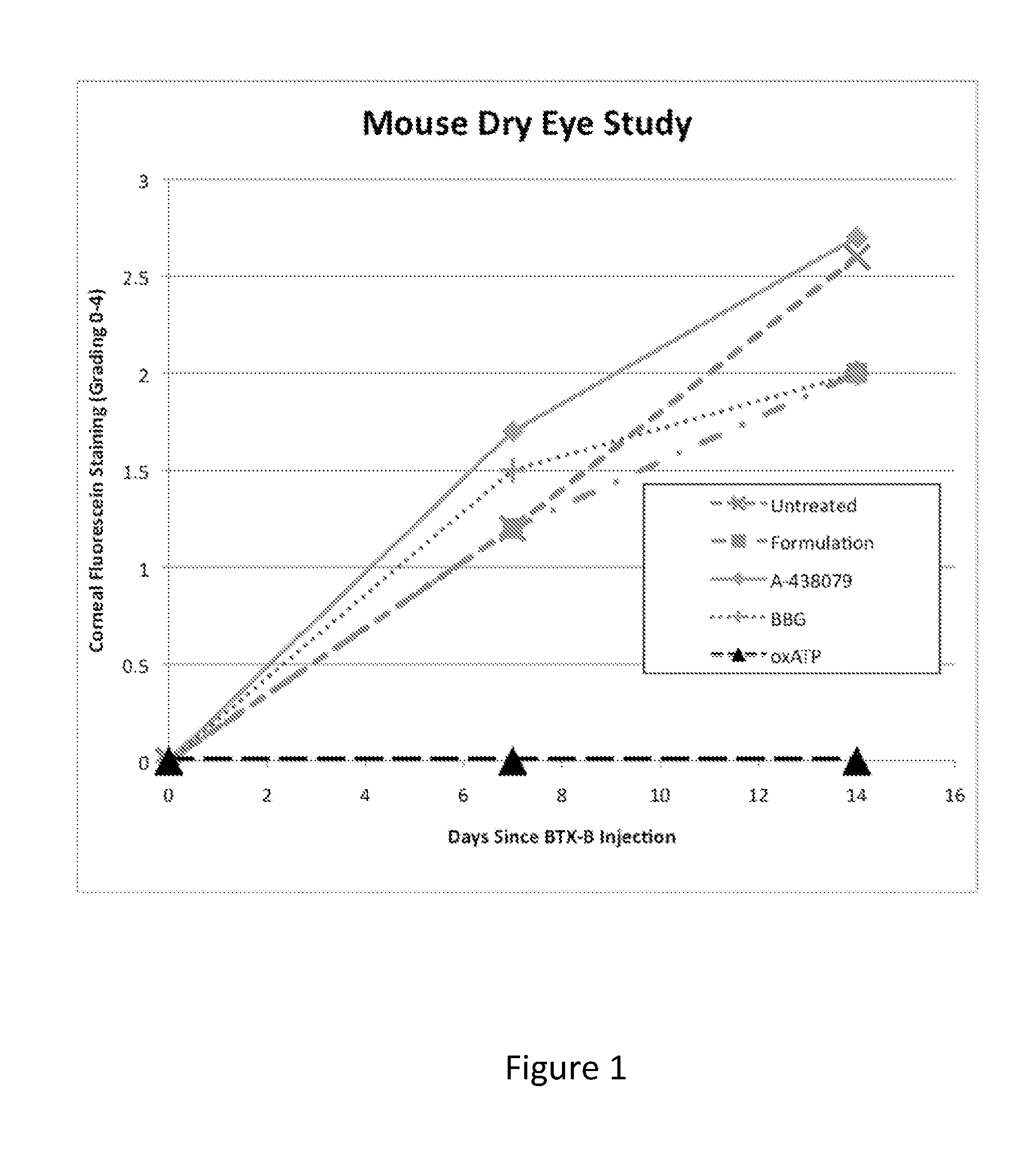Therapies for Disorders of the Cornea and Conjunctiva
a conjunctival and corneal technology, applied in the field of ophthalmic compositions, can solve the problems of insufficient tear production, allergic reaction, infection, damage to the eye surface, and pain associated with damage, and achieve the effect of preventing pathology
- Summary
- Abstract
- Description
- Claims
- Application Information
AI Technical Summary
Benefits of technology
Problems solved by technology
Method used
Image
Examples
example 1
Commercially Available Ophthalmic Formulation
[0172]Compositions of the present invention can be formulated in aqueous or oil based vehicles that are well known to those skilled in the art and are currently used for commercially available products. One formulation for the compositions of the present invention is BSS Sterile Irrigating Solution (Alcon Laboratories, Fort Worth, Tex.). The components include sodium chloride 0.64%, potassium chloride 0.075%, calcium chloride 0.048%, magnesium chloride 0.03%, sodium acetate 0.39%, sodium citrate 0.17%, sodium hydroxide and / or hydrochloric acid to adjust the pH to 7.4, and water. For the present invention, carboxymethylcellulose (CMC) (0.5-1.5%), or other known equivalent thickeners, such as hydroxypropyl methyl cellulose (HPMC) can be added to increase dwell time on the eye.
example 2
Table of Commercially Available Lubricating Ophthalmic Compositions
[0173]Compositions of the present invention can be prepared with formulations similar or identical to the lubricating compositions currently available for dry eye. Such formulations are designed to have extended dwell times on the ocular surface and are thus well-suited for delivery of the active substances of the present invention. Table 1 provides an overview of the currently available lubricating compositions with a brief description of each.
TABLE 1Commercially Available Lubricating Eye DropsArtificial TearsCarboxymethylcellulose (CMC) Artificial TearsOptiveCarboxymethylcellulose sodium 0.5%, Purite preserved.contains compatible solutes (glycerin 0.9%, erythritol,levocarnitine), which protect against cell damage byhyperosmolar tears (osmoprotection).Refresh Tears0.5% CMC Purite as preservative. Refresh Plus Tears also has0.5% CMC, but is preservative-free & comes in single usevials.Refresh Liguigel1% CMC Purite as...
example 3
Mouse Dry Eye Model
[0174]This study validates a mouse model of dry eye described in IOVS 2006 47:133. Rimabotulinum toxin B (BTX-B) (Elan Pharmaceuticals) is injected into a mouse lacrimal gland, which attenuates tear secretion for up to a month and creates a clinical picture of dry eye that mimics that in humans. Specifically, on day 0, female CBA / J mice receive a 50 μl injection of saline containing 20 mU of BTX-B directly into the lacrimal gland of one eye. Control mice receive an injection of physiologic saline into the lacrimal gland of one eye. The eyes are evaluated for tear formation and corneal fluorescein staining (a measure of corneal ulcerations) on days 14 and 28. Relative to the saline injected mice, the BTX-B injected mice display a statistically significant, time dependent decrease in tear production and a statistically significant time dependent increase in fluorescein staining of the cornea. The data indicate that this model may be used to evaluate therapies for dr...
PUM
| Property | Measurement | Unit |
|---|---|---|
| volume | aaaaa | aaaaa |
| temperature | aaaaa | aaaaa |
| temperature | aaaaa | aaaaa |
Abstract
Description
Claims
Application Information
 Login to View More
Login to View More - R&D
- Intellectual Property
- Life Sciences
- Materials
- Tech Scout
- Unparalleled Data Quality
- Higher Quality Content
- 60% Fewer Hallucinations
Browse by: Latest US Patents, China's latest patents, Technical Efficacy Thesaurus, Application Domain, Technology Topic, Popular Technical Reports.
© 2025 PatSnap. All rights reserved.Legal|Privacy policy|Modern Slavery Act Transparency Statement|Sitemap|About US| Contact US: help@patsnap.com

